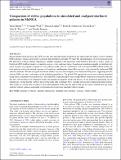Files in this item
Comparison of stellar populations in simulated and real post-starburst galaxies in MaNGA
Item metadata
| dc.contributor.author | Zheng, Yirui | |
| dc.contributor.author | Wild, Vivienne | |
| dc.contributor.author | Lahén, Natalia | |
| dc.contributor.author | Johansson, Peter H. | |
| dc.contributor.author | Law, David | |
| dc.contributor.author | Weaver, John R. | |
| dc.contributor.author | Jimenez, Noelia | |
| dc.date.accessioned | 2020-12-07T15:57:04Z | |
| dc.date.available | 2020-12-07T15:57:04Z | |
| dc.date.issued | 2020-10 | |
| dc.identifier | 269224383 | |
| dc.identifier | 601b34f8-13f6-49d4-af3e-851ab69ec777 | |
| dc.identifier | 85097000484 | |
| dc.identifier | 000587741300087 | |
| dc.identifier.citation | Zheng , Y , Wild , V , Lahén , N , Johansson , P H , Law , D , Weaver , J R & Jimenez , N 2020 , ' Comparison of stellar populations in simulated and real post-starburst galaxies in MaNGA ' , Monthly Notices of the Royal Astronomical Society , vol. 498 , no. 1 , pp. 1259–1277 . https://doi.org/10.1093/mnras/staa2358 | en |
| dc.identifier.issn | 1365-2966 | |
| dc.identifier.other | ArXiv: http://arxiv.org/abs/2005.14112v1 | |
| dc.identifier.uri | https://hdl.handle.net/10023/21084 | |
| dc.description | YZ acknowledges support of a China Scholarship Council – University of St Andrews Scholarship. VW and NJ acknowledge support from the European Research Council Starting Grant SEDMorph (P.I. V. Wild). NL and PHJ acknowledge support by the European Research Council via ERC Consolidator Grant KETJU (no. 818930). | en |
| dc.description.abstract | Recent integral field spectroscopic (IFS) surveys have revealed radial gradients in the optical spectral indices of post-starburst galaxies, which can be used to constrain their formation histories. We study the spectral indices of post-processed mock IFS datacubes of binary merger simulations, carefully matched to the properties of the MaNGA IFS survey, with a variety of black hole feedback models, progenitor galaxies, orbits and mass ratios. Based on our simulation sample, we find that only major mergers on prograde-prograde or retrograde-prograde orbits in combination with a mechanical black hole feedback model can form galaxies with weak enough ongoing star formation, and therefore absent Hα emission, to be selected by traditional PSB selection methods. We find strong fluctuations in nebular emission line strengths, even within the PSB phase, suggesting that Hα selected PSBs are only a subsample of the underlying population. The global PSB population can be more robustly identified using stellar continuum-based approaches. The difficulty in reproducing the very young PSBs in simulations potentially indicates that new sub-resolution star formation recipes are required to properly model the process of star formation quenching. In our simulations, we find that the starburst peaks at the same time at all radii, but is stronger and more prolonged in the inner regions. This results in a strong time evolution in the radial gradients of the spectral indices which can be used to estimate the age of the starburst without reliance on detailed star formation histories from spectral synthesis models. | |
| dc.format.extent | 19 | |
| dc.format.extent | 1642322 | |
| dc.language.iso | eng | |
| dc.relation.ispartof | Monthly Notices of the Royal Astronomical Society | en |
| dc.subject | Galaxies: evolution | en |
| dc.subject | Galaxies: interactions | en |
| dc.subject | Galaxies: star formation | en |
| dc.subject | Galaxies: stellar content | en |
| dc.subject | QC Physics | en |
| dc.subject | QB Astronomy | en |
| dc.subject | DAS | en |
| dc.subject.lcc | QC | en |
| dc.subject.lcc | QB | en |
| dc.title | Comparison of stellar populations in simulated and real post-starburst galaxies in MaNGA | en |
| dc.type | Journal article | en |
| dc.contributor.sponsor | European Research Council | en |
| dc.contributor.institution | University of St Andrews. School of Physics and Astronomy | en |
| dc.identifier.doi | https://doi.org/10.1093/mnras/staa2358 | |
| dc.description.status | Peer reviewed | en |
| dc.identifier.url | https://arxiv.org/abs/2005.14112 | en |
| dc.identifier.grantnumber | ERC-2012-StG-20111012 | en |
This item appears in the following Collection(s)
Items in the St Andrews Research Repository are protected by copyright, with all rights reserved, unless otherwise indicated.

